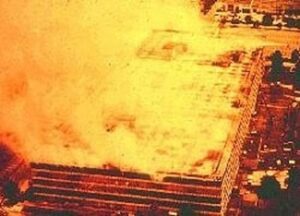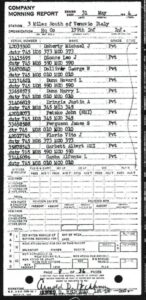Fold3.com, in partnership with the National Archives, recently launched a new collection, U.S. Morning Reports 1912-1946. This collection is a huge opportunity for genealogists studying their military ancestors during World War I and World War II. It is currently only about halfway digitized. The records appear to be complete through 1939.
What’s a morning report? It’s a daily report produced at the company level that indicates any changes in assigned personnel. It may indicate if someone was hospitalized or absent. The details include the name of the soldier, their rank, service number, as well as any notations on status.[1]
I first became acquainted with morning reports a few years ago when I was researching my paternal grandfather, Michael Doherty. He served in the U.S. Army during the Second World War. He served in the 179th Infantry, 45th Division, better known as the Thunderbirds. I knew that the impact of the 1973 fire was going to hinder my efforts to find some of his records.
On 12 July 1973, shortly after midnight, a fire was reported at the National Personnel Records Center (NPRC) in Saint Louis, Missouri. The fire was burning on the sixth floor of the building. Firefighters couldn’t enter the building until two days later. The fire was officially declared burnt out on July 16.[2].
Firefighters couldn’t enter the building until two days later.
It is estimated that 80% of Army and 75% of Air Force Official Military Personnel Records (OMPF) were destroyed in the fire. The OMPF contains details about enlistment, training, promotions, awards, performance, assignments, disciplinary action, and discharge records.[3] It is a consolidated file that is a goldmine of information. The NPRC has been working on reconstructing the records that did survive the fire. This is approximately 6.5 million records in their Burned or “B” Registry File.[4]
While the damage is huge and heartbreaking, we must remember that not all records were destroyed. According to the National Archives, more than 100,000 reels of morning reports for the Army (1912-59) and Air Force (1947-59) were removed from the building.
Up until the announcement that the morning reports were being digitized was published online on Fold3.com, you needed to hire a researcher to go to the NPRC building to review the morning reports on microfilm. I did so a few years back when I was preparing a RootsTech presentation using my grandfather as a case study for World War II.
I pored over the morning reports compiled by the researcher and was able to learn more about my grandfather’s service in the European theater. He started three miles south of Venuvio, Italy on 31 May 1944. The 45th division went through southeastern France. I saw a record of my grandfather’s promotion from Private to TEC5 in March 1945. The division eventually ended up in Munich, Germany.
I know that before reaching Munich, grandfather participated in the liberation of Dachau concentration camp on 29 April 1945. The morning reports in my possession do not seem to capture this event. I will need to re-examine the records when they are fully digitized to see if there is mention of it. Some morning reports include a record of events that occurred.
To search this collection, you can enter the name of the unit or the company. Then you can search by date to narrow down the results. You will not find a morning report every day for your soldier unless there is a change in status (such as being absent, sick, or injured, a promotion, etc.). There are index reels that cover 1912-46.[5]
I hope this post helps give you hope that not everything was destroyed in the 1973 fire. The morning reports can help you rebuild a portion of your soldiers’ military file and place them in the battles in which they participated. I’m excited to learn what discoveries genealogists can find about their veteran soldiers in this new collection. What did you find in the morning reports?
Notes
[1] U.S., Morning Reports 1912-1946, Overview Page, Fold3.com, https://www.fold3.com/publication/1141/us-morning-reports-1912-1946.
[2] The 1973 Fire, National Personnel Records Center, https://www.archives.gov/personnel-records-center/fire-1973.
[3] What is an Official Military Personnel File (OMPF)?, https://www.archives.gov/personnel-records-center/ompf-background.
[4] The 1973 Fire, National Personnel Records Center, https://www.archives.gov/personnel-records-center/fire-1973.
[5] Jenny Ashcraft, “Introducing Our Collection of Morning Reports,” Fold3 blog, 25 April 2022, https://blog.fold3.com/introducing-our-collection-of-morning-reports/.
Share this:

About Melanie McComb
Melanie McComb is a genealogist at NEHGS. She is an experienced international speaker on such topics as researching in Prince Edward Island and using newspapers and DNA in genealogy. Readers may know Melanie from her blog, The Shamrock Genealogist. Melanie holds a bachelor of science degree from the State University of New York at Oswego. Her areas of interest are Connecticut, Massachusetts, New York, New Jersey, Kansas, Prince Edward Island, and Quebec. She is experienced in genetic genealogy, genealogical technology, social media, military records, and Irish and Jewish research.View all posts by Melanie McComb →

